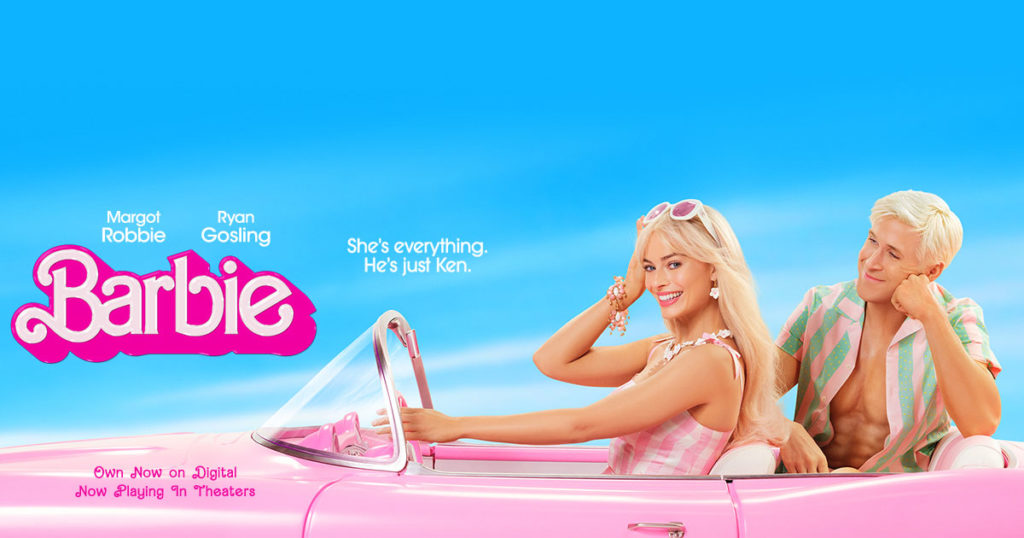
Barbie deserved her own biopic. More than one billion Barbie dolls have been shipped and sold around the world since her premier in 1959, and factories in Asia are still spewing her out. From her hair down to the pink latex paint sweetening her accessories, Barbie is made from petroleum. Landfills may yield many archeological treasures in the distant future. Perhaps in galactic museums, alongside Minoan clay goddess figurines, a host of Barbie dolls will represent our epoch’s female deity worship.
Despite the hype, among many the bar was low for Greta Gerwig’s 2023 Barbie the movie. Who expected a funny and subversive film about a blonde Barbie doll? Dolls are dumb. For girls. Toxic psychologically. Toxic literally. A commercial product. Mainstream. “I’ll wait until I can see it for free,” some said.
Others of us could hardly wait. I confess to being one of those. I dug out my pink pussy hat, loaded into a sedan with four girlfriends, and on a hot summer night in June climbed to a high row to find five seats together in a crowded local movie theater.
I’m an original member of the Barbie cult. Barbie came out—as a doll—in 1959, when I was four years old. My father bought me my first Barbie as a gift when he came home to our duplex on the south side of Chicago after a week away for work. On subsequent trips, he added a Ken doll and a Barbie convertible car to my collection. I was hot stuff on the block.
My younger self inherently understood that adoring Barbie was a social imperative, and even though I had found dolls and stuffed animals mostly boring up to that point, Barbie was different from those baby playthings. Barbie was from the world of television. And television was nearly as new as this eleven-inch doll that looked like a young woman who might someday wear bunny ears. Playboy magazine was also fashionable in 1959, having been launched only six years earlier.
Yes, Barbie had an undercurrent of being a sexy plaything. She came dressed in a swimsuit, just like beauty pageant contestants. I could hold Barbie’s entire body with her molded plastic bosom in my four-year-old hands. A few years later, an older friend used Barbie and Ken to illustrate “how babies are made.”
Brand new television screens were as absorbing as smartphones are today. I spent many hours sitting two feet away from the magic machine when I was four. No doubt I saw Barbie’s first commercial, which was aired on the Mickey Mouse Club in 1959. The lyrics, sung by a woman with a Doris Day voice, pronounced her allure:
“Barbie you’re beautiful. You make me feel my Barbie doll is really real. Barbie’s small and so petite. Her clothes and figure look so neat. Her dancing outfit rings a bell. At parties she will cast a spell. Purse and hats and gloves galore and all the gadgets gals adore. Someday I’m gonna be exactly like you. Till then I know just what I’ll do. I’ll make believe that I am you.”
The doll encourages girls to project themselves into monied older selves who can afford new clothes, accessories, houses, cars, and dream vacations. Consumerism is beautiful.
Over the decades the Mattel Corporation has gone through their diversity evolution. Barbies are now available in variety of body types (curvy, tall, petite), ethnicities, professions, and hobbies. In 2019, it released a doll that uses a wheelchair and another with a prosthetic leg. And today we can buy Barbie and Ken dolls modeled after Margot Robbie and Ryan Gosling, stars of the international hit film.
Writer/director Greta Gerwig’s cleverly layered film pops with marvelous art direction, spot-on acting, and a clever script. The film takes us to Barbie Land, a dream world of female supremacy. Barbies run everything. Barbie is president. Barbie delivers the mail. And Barbie the highway worker doll-handles her pink jackhammer with aplomb.
As the various Barbies chime in to each other in the opening scenes, it’s always “the best day ever” in Barbie Land: sunny, efficient, competent, fun, friendly, stylish, and teasingly chaste.
Yes, there are Kens—but they live only to get attention from Barbies and do no real work. The official website for the film proclaims: “She’s everything. He’s just Ken.”
The internal mythology of Barbie Land teaches the dolls that they were created to help real girls imagine themselves as fully confident, liberated women. When the plot moves the protagonist, called Ordinary Barbie, into the “real world,” she expects girls and women to be adoring and grateful to her. Instead, she faces vitriol from some smart young women who reject her demanding standards of impossible beauty. What is Ordinary Barbie to do?
I forgive Gerwig and her writing partner Noah Baumbach any awkward twists. They managed to wrangle a plot about gender norms, self-esteem, and mother-daughter relationships out of this dress-up world. And they concocted a narrative that draws in all ages and people. The story’s frame features real history of the Barbie franchise. The result gently satirizes the Barbie franchise while keeping it honeyed for their co-producers Mattel and Warner Bros.
The plot is a coming-of-age story for Barbie, as she ventures out of idealistic Barbie Land into the real world on a quest with Ken, where they both confront male dominance, but with opposite reactions. Unlike in Barbie Land, where any ambitions of his are totally stymied, Ken relishes this world where he has action and power. The tables turn. The confrontational stage is set. (No spoilers here.) The resolution is a bit of a muddle, but there is a car chase, some on-the–nose consciousness-raising, and a hilarious capper.
I enjoyed the plot for its use of reversal in contrasting female and male dominance. Stark reversal in a story helps us think. Given how society has developed since 1959, I wonder how younger-than-me boys and girls, women and men, and non-binary folks interpret this disarmingly provocative film.
As a girl, I loved Barbie; as a pre-teen I had to diminish Barbie to liberate myself from her; and now, well, I guess I’m her older sister, and sisterhood is powerful. When does Hag Barbie make her debut?
Perhaps Gerwig and Baumbach will feature G.I. Joe for their next film. In 1964 Hasbro released this action figure—don’t call him a doll—who for decades became an enormously popular toy for boys. Maybe Joe can grow tired of make-believe war and go to real war. How will that story end?

Audrey Wells, a former longtime resident of Urbana-Champaign, is a retired educator and freelance writer.
782 total views, 1 views today
